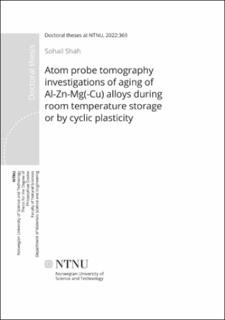| dc.contributor.advisor | Holmedal, Bjørn | |
| dc.contributor.advisor | Holmestad, Randi | |
| dc.contributor.advisor | Marioara, Calin | |
| dc.contributor.advisor | Wenner, Sigurd | |
| dc.contributor.author | Shah, Sohail | |
| dc.date.accessioned | 2022-12-21T10:25:20Z | |
| dc.date.available | 2022-12-21T10:25:20Z | |
| dc.date.issued | 2022 | |
| dc.identifier.isbn | 978-82-326-6973-8 | |
| dc.identifier.issn | 2703-8084 | |
| dc.identifier.uri | https://hdl.handle.net/11250/3038996 | |
| dc.description.abstract | Aluminum alloys containing zinc, magnesium, and copper attain strength by forming nanoparticles during thermal treatments. To generate particles by precipitation, first the alloy has to be heated to about 480°C to dissolve all elements; then quenched, so that the precipitation of these nanoparticles can take place afterwards, either during storage at room temperature for several months or at about 140°C for nine hours.
In this work, the strengthening at room/elevated temperatures, was replaced by a sequence of cyclic deformations at room temperature. A key question was to figure out what kind of particles would form by this new processing technique? Would they be of the same type and give similar strength as those formed during storage at elevated/room temperature, or would they have another undiscovered structure? A main finding from this study is that the small particles of about one to two nanometer diameter formed during cyclic deformation are similar in size, chemistry and structure, to those of traditional techniques. It was discovered that a further storage for about a week at room temperature enhanced the material strength significantly.
Another important finding was noted when testing the strength and formability of the strengthened material. Samples forming nanoparticles during room temperature storage or cyclic deformation were prone to early slant ductile fractures during testing. For such alloys which may be applied in car bumpers and protective structures; understanding of such an early fracture is very important.
This work involved use of the Atom Probe Tomography technique to quantify the nanoscale particles. Two different methods were employed to analyze the data: a cluster identification method and a more statistical approach. Much of the work was focused on understanding the effect of resolution on the accurate quantification, estimation of the chemical composition and the number and size of the nanoparticles. Progress has been made in how to precisely interpret Atom Probe Tomography measurements of such alloys with their nanoparticles around 1-2 nanometers in size. | en_US |
| dc.language.iso | eng | en_US |
| dc.publisher | NTNU | en_US |
| dc.relation.ispartofseries | Doctoral theses at NTNU;2022:369 | |
| dc.relation.haspart | Paper 1: Shah, Sohail; Thronsen, Elisabeth; Hatzoglou, Constantinos; Wenner, Sigurd; Marioara, Calin Daniel; Holmestad, Randi; Holmedal, Bjørn. Effect of cyclic ageing on the early-stage clustering in Al–Zn–Mg(-Cu) alloys. Materials Science & Engineering: A 2022 ;Volum 846. s. 1-10 | en_US |
| dc.relation.haspart | Paper 2: Shah, Sohail; Gopal, Akash; Thronsen, Elisabeth; Hatzoglou, Constantinos; Holmedal, Bjørn. Precipitation, mechanical properties and early slant ductile fracture in cyclic and naturally aged Al-Zn-Mg(-Cu) alloys. Materials & design 2022 ;Volum 222. | en_US |
| dc.relation.haspart | Paper 3: Shah, Sohail; Thronsen, Elisabeth; De Geuser, Frederic; Hatzoglou, Constantinos; Marioara, Calin Daniel; Holmestad, Randi; Holmedal, Bjørn. “Comparison of a cluster identification method to a statistical approach for analyzing atom probe tomography data for GP zones in Al- Zn-Mg(-Cu) alloys”. Manuscript ready for submission in Microscopy and Microanalysis. This paper is not yet published and is therefore not included. | en_US |
| dc.relation.haspart | Paper 4: Thronsen, Elisabeth; Shah, Sohail; Hatzoglou, Constantinos; Marioara, Calin Daniel Wenner, Sigurd; Anderson, Sigmund J.; Holmedal, Bjørn; Holmestad, Randi. “The evolution of precipitates in an Al-Zn-Mg alloy”. Ready for submission in Journal of Alloys and Compounds. This paper is not yet published and is therefore not included. | en_US |
| dc.title | Atom probe tomography investigations of aging of Al-Zn-Mg(-Cu) alloys during room temperature storage or by cyclic plasticity | en_US |
| dc.type | Doctoral thesis | en_US |
| dc.subject.nsi | VDP::Teknologi: 500::Materialteknologi: 520 | en_US |

